University HRM Report: Obligations of Casual Employment in Australia
VerifiedAdded on 2022/10/11
|10
|2209
|23
Report
AI Summary
This report examines the prevalence and implications of casual employment in Australia, focusing on the retail sector. It explores the obligations of organizations towards casual workers, considering legal entitlements, working conditions, and the experiences of employees. The report analyzes factors influencing worker empowerment, such as knowledge of workplace rights and the impact of social background. It also discusses the perspectives of managers and the broader policy context, including arguments for and against casual employment. The report references various studies and articles to support its analysis, ultimately concluding with a call for changes in casual employment to ensure equal rights and social responsibility for workers. The report also suggests the need for more research on the casual employment structure to understand the future of employment in Australia.
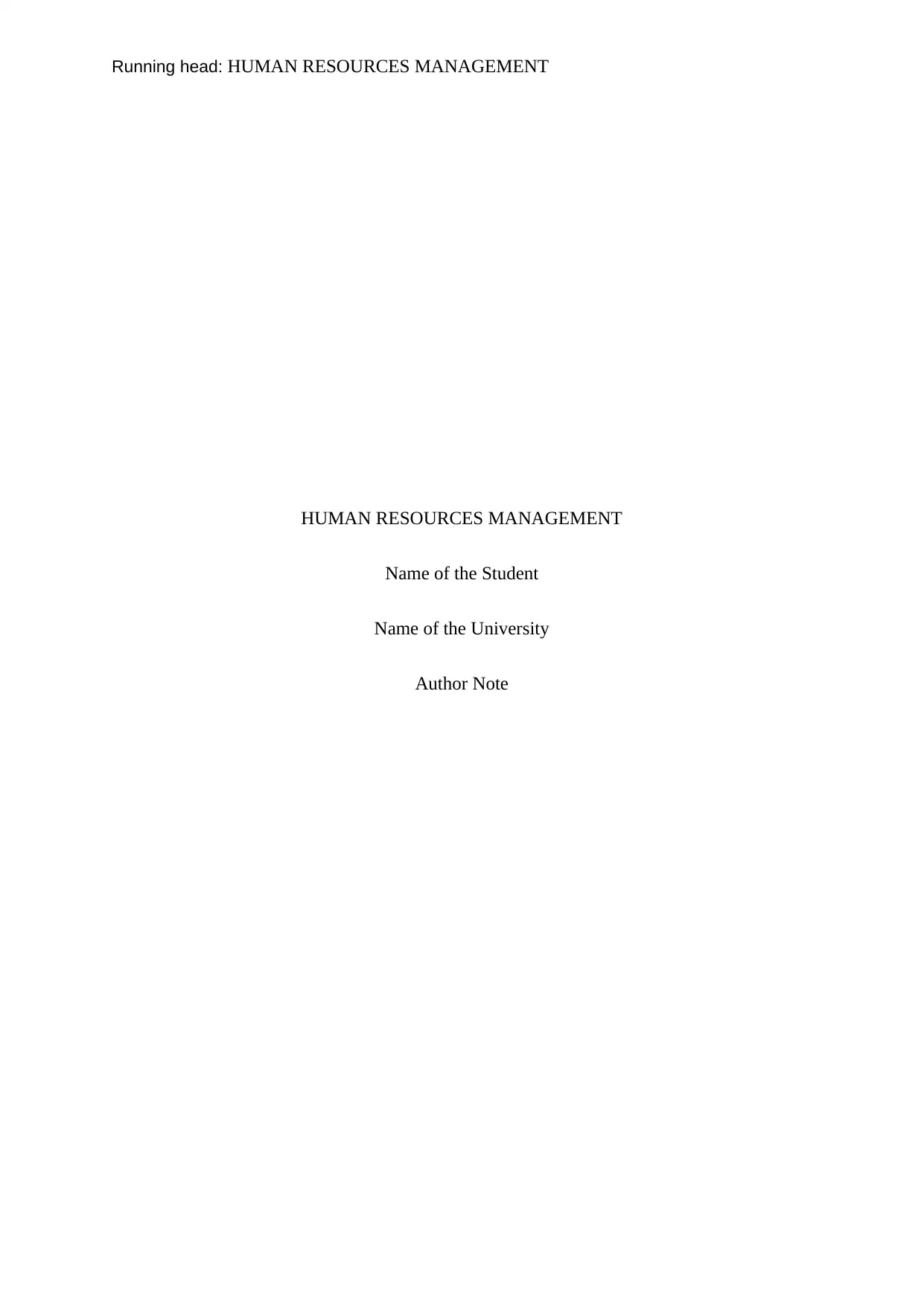
Running head: HUMAN RESOURCES MANAGEMENT
HUMAN RESOURCES MANAGEMENT
Name of the Student
Name of the University
Author Note
HUMAN RESOURCES MANAGEMENT
Name of the Student
Name of the University
Author Note
Paraphrase This Document
Need a fresh take? Get an instant paraphrase of this document with our AI Paraphraser
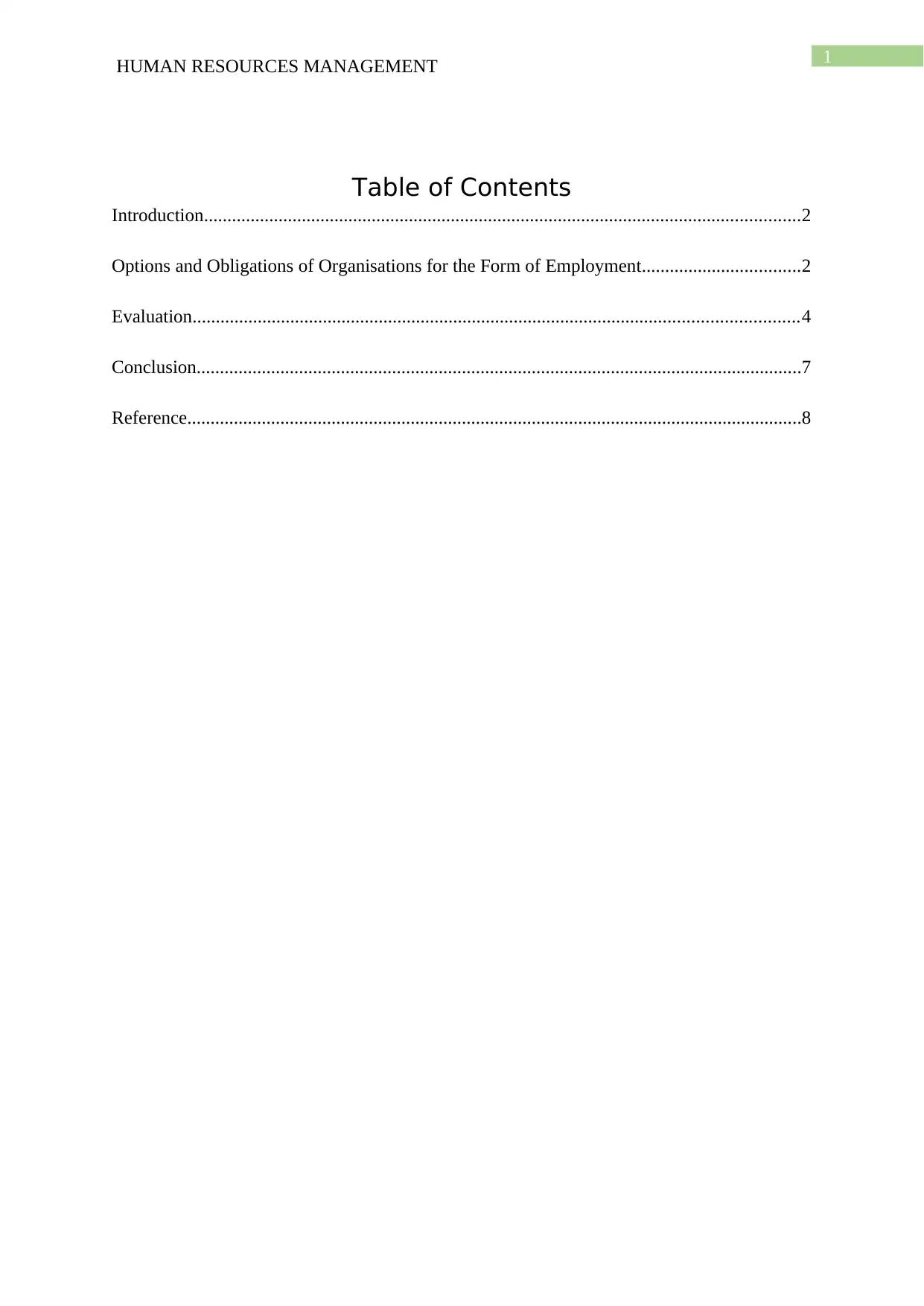
1
HUMAN RESOURCES MANAGEMENT
Table of Contents
Introduction................................................................................................................................2
Options and Obligations of Organisations for the Form of Employment..................................2
Evaluation..................................................................................................................................4
Conclusion..................................................................................................................................7
Reference....................................................................................................................................8
HUMAN RESOURCES MANAGEMENT
Table of Contents
Introduction................................................................................................................................2
Options and Obligations of Organisations for the Form of Employment..................................2
Evaluation..................................................................................................................................4
Conclusion..................................................................................................................................7
Reference....................................................................................................................................8
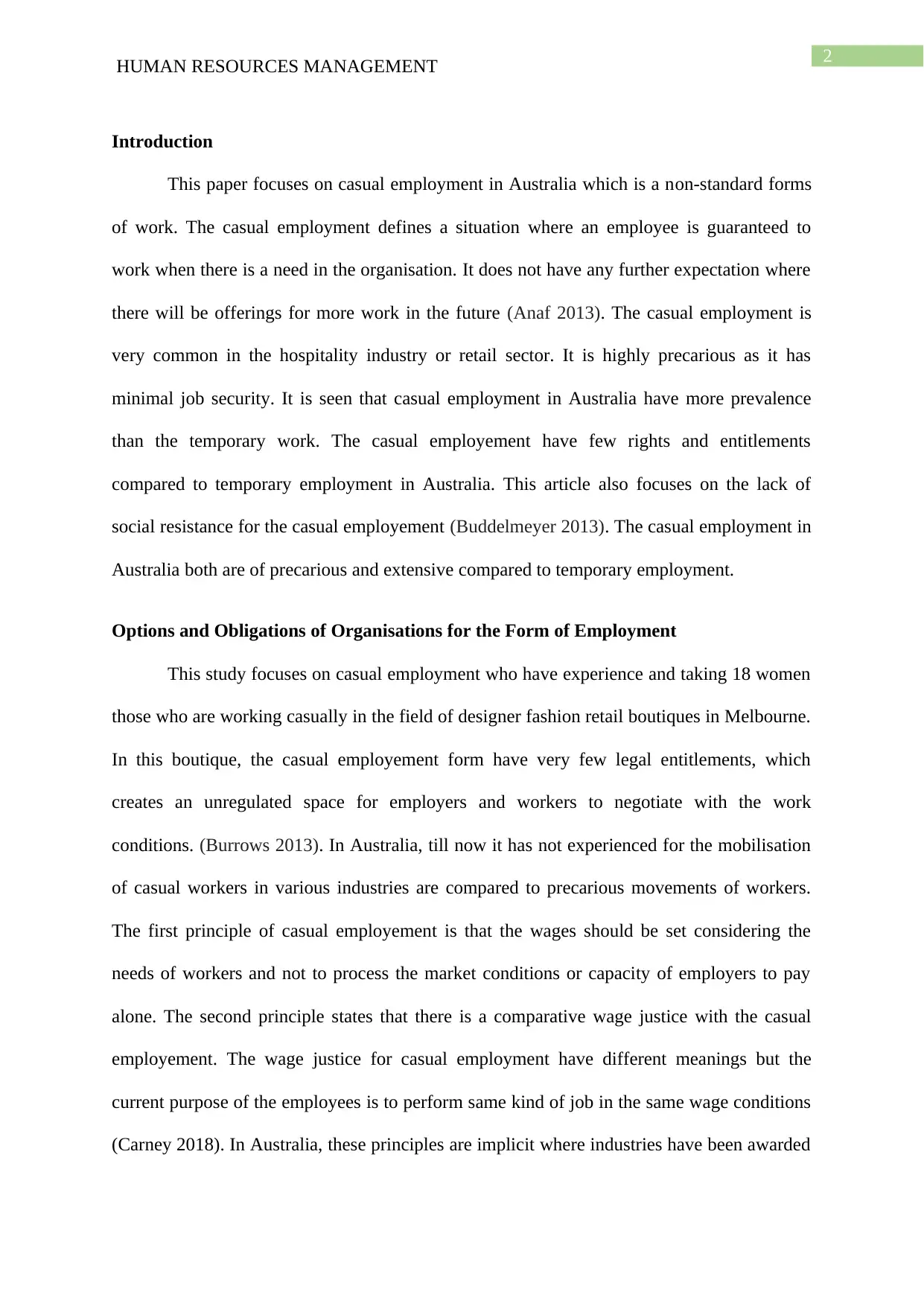
2
HUMAN RESOURCES MANAGEMENT
Introduction
This paper focuses on casual employment in Australia which is a non-standard forms
of work. The casual employment defines a situation where an employee is guaranteed to
work when there is a need in the organisation. It does not have any further expectation where
there will be offerings for more work in the future (Anaf 2013). The casual employment is
very common in the hospitality industry or retail sector. It is highly precarious as it has
minimal job security. It is seen that casual employment in Australia have more prevalence
than the temporary work. The casual employement have few rights and entitlements
compared to temporary employment in Australia. This article also focuses on the lack of
social resistance for the casual employement (Buddelmeyer 2013). The casual employment in
Australia both are of precarious and extensive compared to temporary employment.
Options and Obligations of Organisations for the Form of Employment
This study focuses on casual employment who have experience and taking 18 women
those who are working casually in the field of designer fashion retail boutiques in Melbourne.
In this boutique, the casual employement form have very few legal entitlements, which
creates an unregulated space for employers and workers to negotiate with the work
conditions. (Burrows 2013). In Australia, till now it has not experienced for the mobilisation
of casual workers in various industries are compared to precarious movements of workers.
The first principle of casual employement is that the wages should be set considering the
needs of workers and not to process the market conditions or capacity of employers to pay
alone. The second principle states that there is a comparative wage justice with the casual
employement. The wage justice for casual employment have different meanings but the
current purpose of the employees is to perform same kind of job in the same wage conditions
(Carney 2018). In Australia, these principles are implicit where industries have been awarded
HUMAN RESOURCES MANAGEMENT
Introduction
This paper focuses on casual employment in Australia which is a non-standard forms
of work. The casual employment defines a situation where an employee is guaranteed to
work when there is a need in the organisation. It does not have any further expectation where
there will be offerings for more work in the future (Anaf 2013). The casual employment is
very common in the hospitality industry or retail sector. It is highly precarious as it has
minimal job security. It is seen that casual employment in Australia have more prevalence
than the temporary work. The casual employement have few rights and entitlements
compared to temporary employment in Australia. This article also focuses on the lack of
social resistance for the casual employement (Buddelmeyer 2013). The casual employment in
Australia both are of precarious and extensive compared to temporary employment.
Options and Obligations of Organisations for the Form of Employment
This study focuses on casual employment who have experience and taking 18 women
those who are working casually in the field of designer fashion retail boutiques in Melbourne.
In this boutique, the casual employement form have very few legal entitlements, which
creates an unregulated space for employers and workers to negotiate with the work
conditions. (Burrows 2013). In Australia, till now it has not experienced for the mobilisation
of casual workers in various industries are compared to precarious movements of workers.
The first principle of casual employement is that the wages should be set considering the
needs of workers and not to process the market conditions or capacity of employers to pay
alone. The second principle states that there is a comparative wage justice with the casual
employement. The wage justice for casual employment have different meanings but the
current purpose of the employees is to perform same kind of job in the same wage conditions
(Carney 2018). In Australia, these principles are implicit where industries have been awarded
⊘ This is a preview!⊘
Do you want full access?
Subscribe today to unlock all pages.

Trusted by 1+ million students worldwide
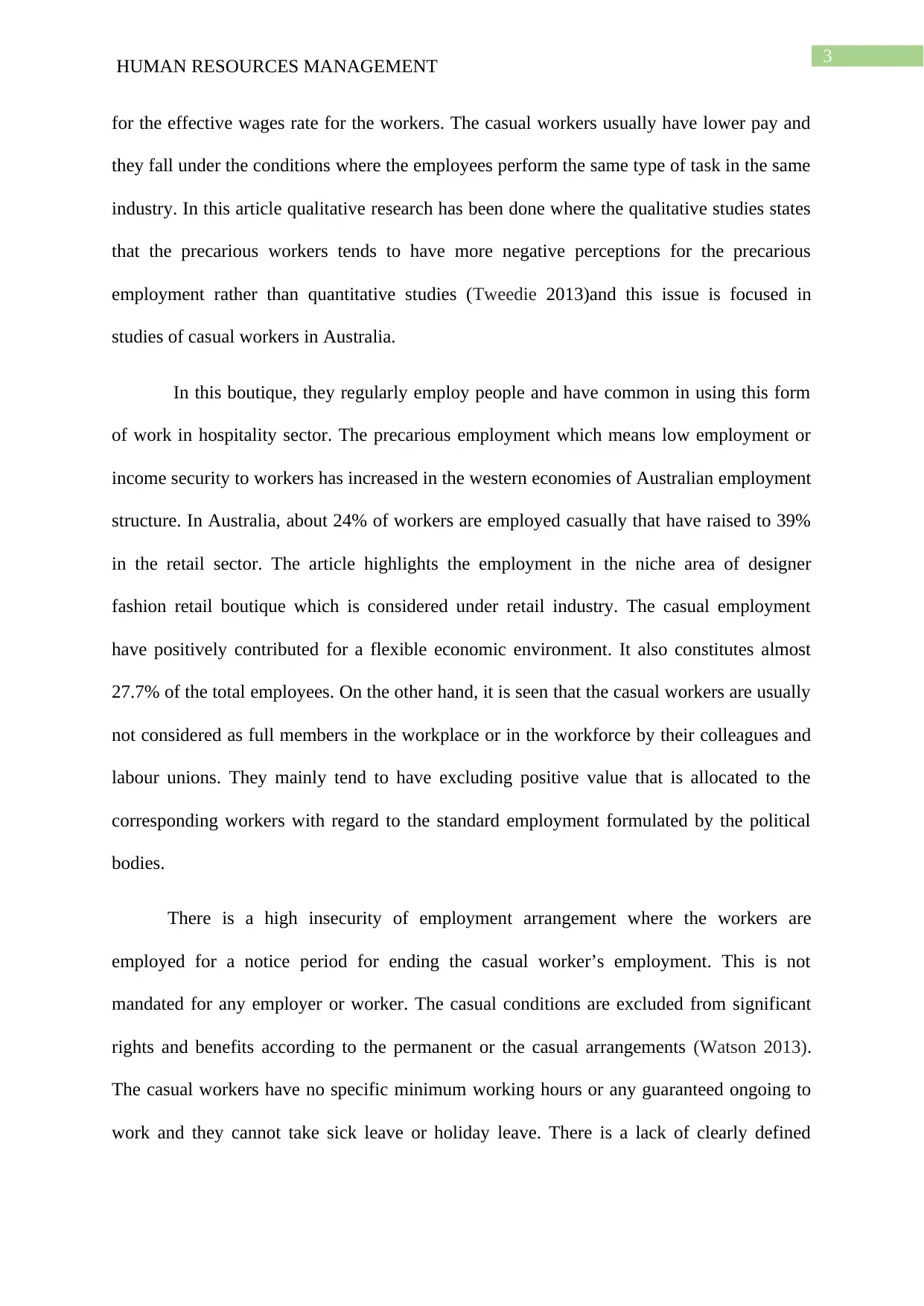
3
HUMAN RESOURCES MANAGEMENT
for the effective wages rate for the workers. The casual workers usually have lower pay and
they fall under the conditions where the employees perform the same type of task in the same
industry. In this article qualitative research has been done where the qualitative studies states
that the precarious workers tends to have more negative perceptions for the precarious
employment rather than quantitative studies (Tweedie 2013)and this issue is focused in
studies of casual workers in Australia.
In this boutique, they regularly employ people and have common in using this form
of work in hospitality sector. The precarious employment which means low employment or
income security to workers has increased in the western economies of Australian employment
structure. In Australia, about 24% of workers are employed casually that have raised to 39%
in the retail sector. The article highlights the employment in the niche area of designer
fashion retail boutique which is considered under retail industry. The casual employment
have positively contributed for a flexible economic environment. It also constitutes almost
27.7% of the total employees. On the other hand, it is seen that the casual workers are usually
not considered as full members in the workplace or in the workforce by their colleagues and
labour unions. They mainly tend to have excluding positive value that is allocated to the
corresponding workers with regard to the standard employment formulated by the political
bodies.
There is a high insecurity of employment arrangement where the workers are
employed for a notice period for ending the casual worker’s employment. This is not
mandated for any employer or worker. The casual conditions are excluded from significant
rights and benefits according to the permanent or the casual arrangements (Watson 2013).
The casual workers have no specific minimum working hours or any guaranteed ongoing to
work and they cannot take sick leave or holiday leave. There is a lack of clearly defined
HUMAN RESOURCES MANAGEMENT
for the effective wages rate for the workers. The casual workers usually have lower pay and
they fall under the conditions where the employees perform the same type of task in the same
industry. In this article qualitative research has been done where the qualitative studies states
that the precarious workers tends to have more negative perceptions for the precarious
employment rather than quantitative studies (Tweedie 2013)and this issue is focused in
studies of casual workers in Australia.
In this boutique, they regularly employ people and have common in using this form
of work in hospitality sector. The precarious employment which means low employment or
income security to workers has increased in the western economies of Australian employment
structure. In Australia, about 24% of workers are employed casually that have raised to 39%
in the retail sector. The article highlights the employment in the niche area of designer
fashion retail boutique which is considered under retail industry. The casual employment
have positively contributed for a flexible economic environment. It also constitutes almost
27.7% of the total employees. On the other hand, it is seen that the casual workers are usually
not considered as full members in the workplace or in the workforce by their colleagues and
labour unions. They mainly tend to have excluding positive value that is allocated to the
corresponding workers with regard to the standard employment formulated by the political
bodies.
There is a high insecurity of employment arrangement where the workers are
employed for a notice period for ending the casual worker’s employment. This is not
mandated for any employer or worker. The casual conditions are excluded from significant
rights and benefits according to the permanent or the casual arrangements (Watson 2013).
The casual workers have no specific minimum working hours or any guaranteed ongoing to
work and they cannot take sick leave or holiday leave. There is a lack of clearly defined
Paraphrase This Document
Need a fresh take? Get an instant paraphrase of this document with our AI Paraphraser
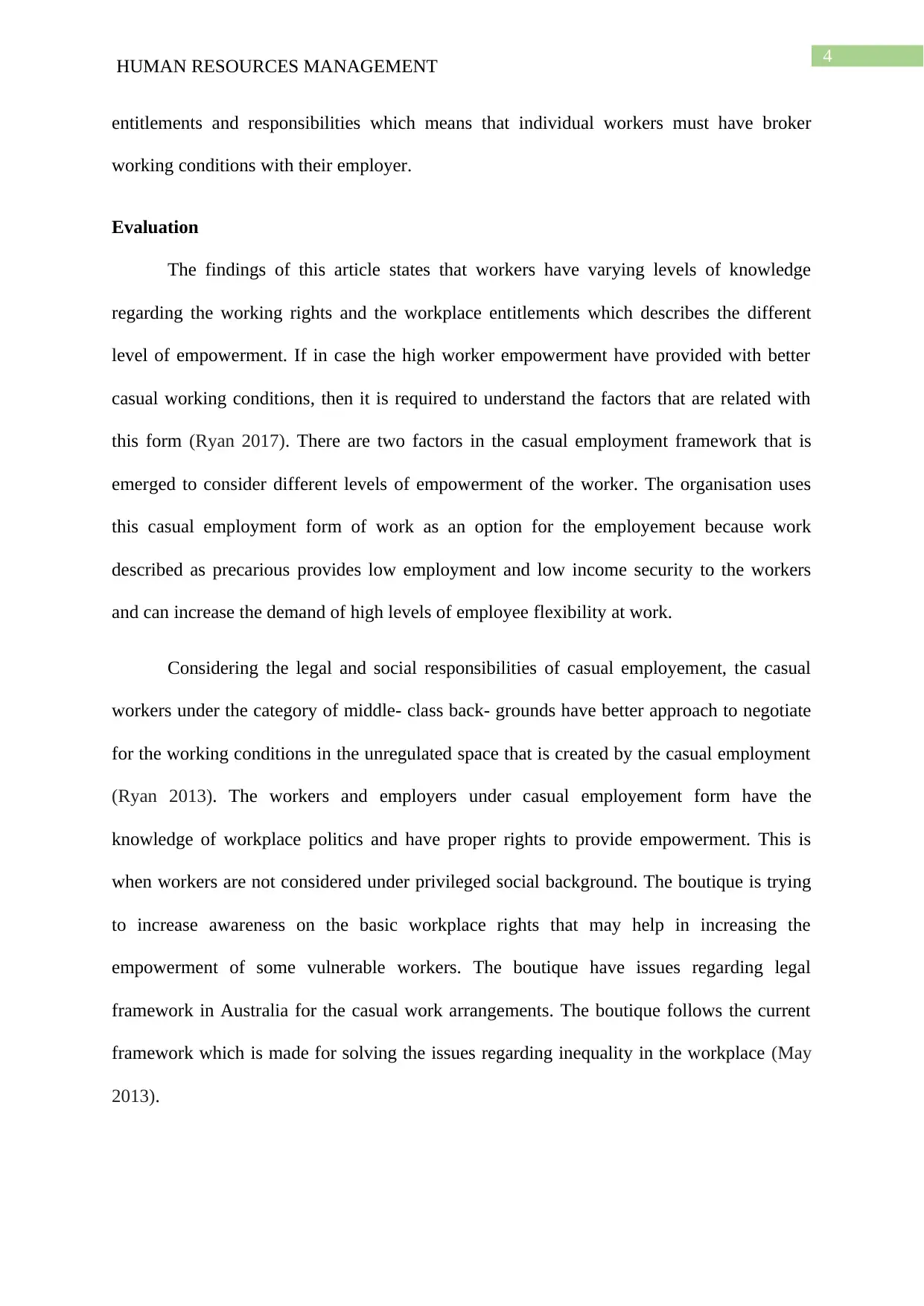
4
HUMAN RESOURCES MANAGEMENT
entitlements and responsibilities which means that individual workers must have broker
working conditions with their employer.
Evaluation
The findings of this article states that workers have varying levels of knowledge
regarding the working rights and the workplace entitlements which describes the different
level of empowerment. If in case the high worker empowerment have provided with better
casual working conditions, then it is required to understand the factors that are related with
this form (Ryan 2017). There are two factors in the casual employment framework that is
emerged to consider different levels of empowerment of the worker. The organisation uses
this casual employment form of work as an option for the employement because work
described as precarious provides low employment and low income security to the workers
and can increase the demand of high levels of employee flexibility at work.
Considering the legal and social responsibilities of casual employement, the casual
workers under the category of middle- class back- grounds have better approach to negotiate
for the working conditions in the unregulated space that is created by the casual employment
(Ryan 2013). The workers and employers under casual employement form have the
knowledge of workplace politics and have proper rights to provide empowerment. This is
when workers are not considered under privileged social background. The boutique is trying
to increase awareness on the basic workplace rights that may help in increasing the
empowerment of some vulnerable workers. The boutique have issues regarding legal
framework in Australia for the casual work arrangements. The boutique follows the current
framework which is made for solving the issues regarding inequality in the workplace (May
2013).
HUMAN RESOURCES MANAGEMENT
entitlements and responsibilities which means that individual workers must have broker
working conditions with their employer.
Evaluation
The findings of this article states that workers have varying levels of knowledge
regarding the working rights and the workplace entitlements which describes the different
level of empowerment. If in case the high worker empowerment have provided with better
casual working conditions, then it is required to understand the factors that are related with
this form (Ryan 2017). There are two factors in the casual employment framework that is
emerged to consider different levels of empowerment of the worker. The organisation uses
this casual employment form of work as an option for the employement because work
described as precarious provides low employment and low income security to the workers
and can increase the demand of high levels of employee flexibility at work.
Considering the legal and social responsibilities of casual employement, the casual
workers under the category of middle- class back- grounds have better approach to negotiate
for the working conditions in the unregulated space that is created by the casual employment
(Ryan 2013). The workers and employers under casual employement form have the
knowledge of workplace politics and have proper rights to provide empowerment. This is
when workers are not considered under privileged social background. The boutique is trying
to increase awareness on the basic workplace rights that may help in increasing the
empowerment of some vulnerable workers. The boutique have issues regarding legal
framework in Australia for the casual work arrangements. The boutique follows the current
framework which is made for solving the issues regarding inequality in the workplace (May
2013).
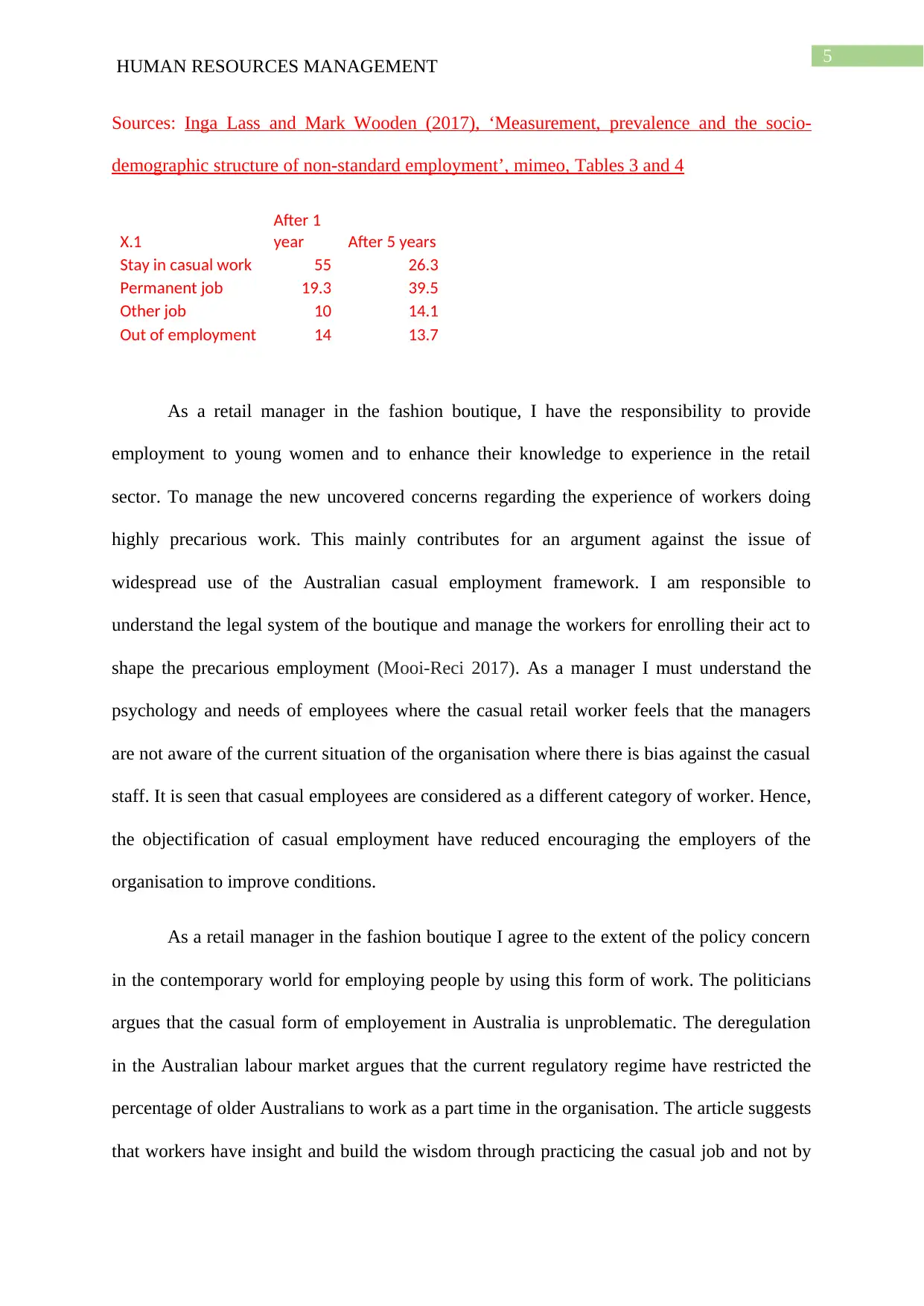
5
HUMAN RESOURCES MANAGEMENT
Sources: Inga Lass and Mark Wooden (2017), ‘Measurement, prevalence and the socio-
demographic structure of non-standard employment’, mimeo, Tables 3 and 4
X.1
After 1
year After 5 years
Stay in casual work 55 26.3
Permanent job 19.3 39.5
Other job 10 14.1
Out of employment 14 13.7
As a retail manager in the fashion boutique, I have the responsibility to provide
employment to young women and to enhance their knowledge to experience in the retail
sector. To manage the new uncovered concerns regarding the experience of workers doing
highly precarious work. This mainly contributes for an argument against the issue of
widespread use of the Australian casual employment framework. I am responsible to
understand the legal system of the boutique and manage the workers for enrolling their act to
shape the precarious employment (Mooi-Reci 2017). As a manager I must understand the
psychology and needs of employees where the casual retail worker feels that the managers
are not aware of the current situation of the organisation where there is bias against the casual
staff. It is seen that casual employees are considered as a different category of worker. Hence,
the objectification of casual employment have reduced encouraging the employers of the
organisation to improve conditions.
As a retail manager in the fashion boutique I agree to the extent of the policy concern
in the contemporary world for employing people by using this form of work. The politicians
argues that the casual form of employement in Australia is unproblematic. The deregulation
in the Australian labour market argues that the current regulatory regime have restricted the
percentage of older Australians to work as a part time in the organisation. The article suggests
that workers have insight and build the wisdom through practicing the casual job and not by
HUMAN RESOURCES MANAGEMENT
Sources: Inga Lass and Mark Wooden (2017), ‘Measurement, prevalence and the socio-
demographic structure of non-standard employment’, mimeo, Tables 3 and 4
X.1
After 1
year After 5 years
Stay in casual work 55 26.3
Permanent job 19.3 39.5
Other job 10 14.1
Out of employment 14 13.7
As a retail manager in the fashion boutique, I have the responsibility to provide
employment to young women and to enhance their knowledge to experience in the retail
sector. To manage the new uncovered concerns regarding the experience of workers doing
highly precarious work. This mainly contributes for an argument against the issue of
widespread use of the Australian casual employment framework. I am responsible to
understand the legal system of the boutique and manage the workers for enrolling their act to
shape the precarious employment (Mooi-Reci 2017). As a manager I must understand the
psychology and needs of employees where the casual retail worker feels that the managers
are not aware of the current situation of the organisation where there is bias against the casual
staff. It is seen that casual employees are considered as a different category of worker. Hence,
the objectification of casual employment have reduced encouraging the employers of the
organisation to improve conditions.
As a retail manager in the fashion boutique I agree to the extent of the policy concern
in the contemporary world for employing people by using this form of work. The politicians
argues that the casual form of employement in Australia is unproblematic. The deregulation
in the Australian labour market argues that the current regulatory regime have restricted the
percentage of older Australians to work as a part time in the organisation. The article suggests
that workers have insight and build the wisdom through practicing the casual job and not by
⊘ This is a preview!⊘
Do you want full access?
Subscribe today to unlock all pages.

Trusted by 1+ million students worldwide
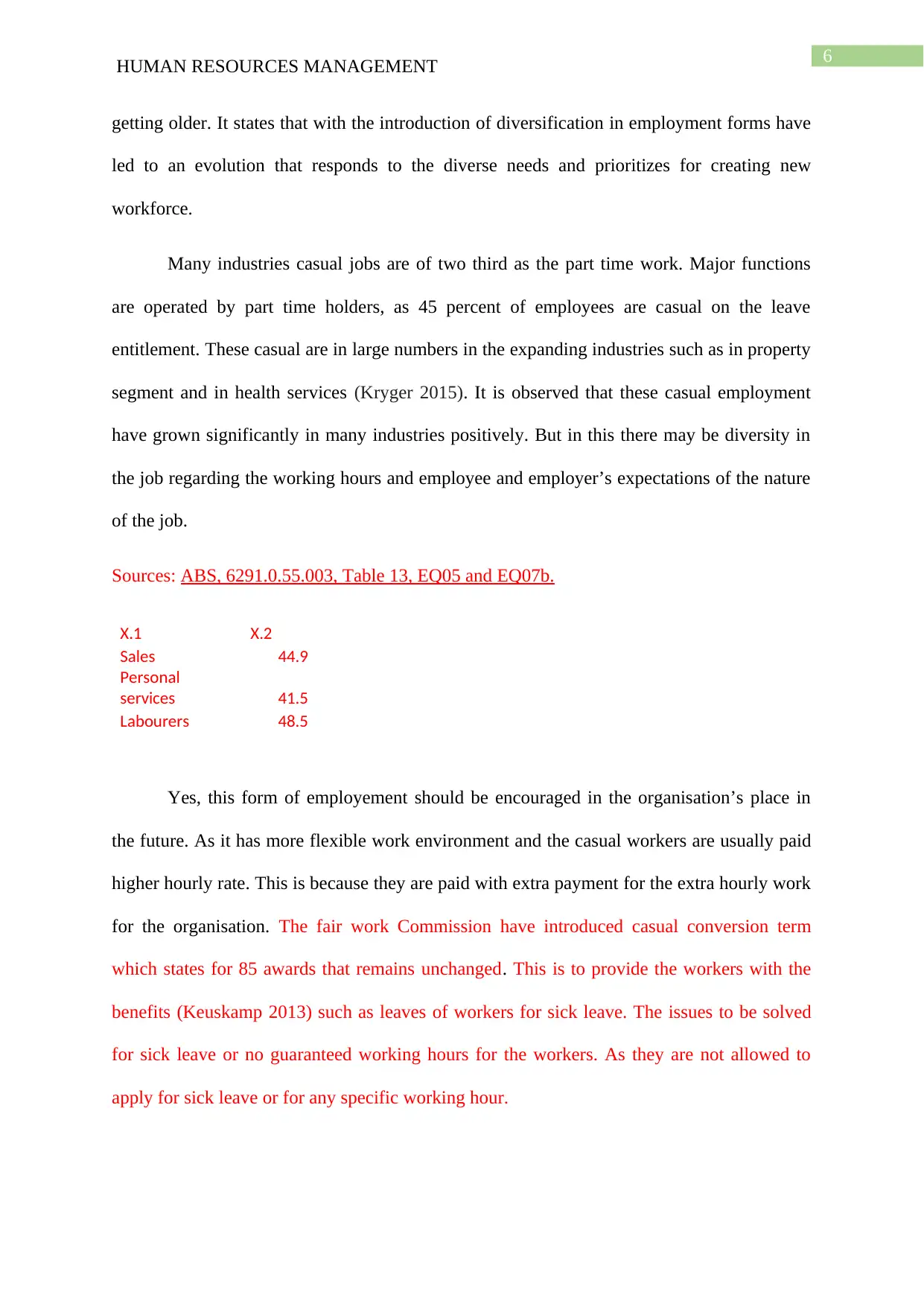
6
HUMAN RESOURCES MANAGEMENT
getting older. It states that with the introduction of diversification in employment forms have
led to an evolution that responds to the diverse needs and prioritizes for creating new
workforce.
Many industries casual jobs are of two third as the part time work. Major functions
are operated by part time holders, as 45 percent of employees are casual on the leave
entitlement. These casual are in large numbers in the expanding industries such as in property
segment and in health services (Kryger 2015). It is observed that these casual employment
have grown significantly in many industries positively. But in this there may be diversity in
the job regarding the working hours and employee and employer’s expectations of the nature
of the job.
Sources: ABS, 6291.0.55.003, Table 13, EQ05 and EQ07b.
X.1 X.2
Sales 44.9
Personal
services 41.5
Labourers 48.5
Yes, this form of employement should be encouraged in the organisation’s place in
the future. As it has more flexible work environment and the casual workers are usually paid
higher hourly rate. This is because they are paid with extra payment for the extra hourly work
for the organisation. The fair work Commission have introduced casual conversion term
which states for 85 awards that remains unchanged. This is to provide the workers with the
benefits (Keuskamp 2013) such as leaves of workers for sick leave. The issues to be solved
for sick leave or no guaranteed working hours for the workers. As they are not allowed to
apply for sick leave or for any specific working hour.
HUMAN RESOURCES MANAGEMENT
getting older. It states that with the introduction of diversification in employment forms have
led to an evolution that responds to the diverse needs and prioritizes for creating new
workforce.
Many industries casual jobs are of two third as the part time work. Major functions
are operated by part time holders, as 45 percent of employees are casual on the leave
entitlement. These casual are in large numbers in the expanding industries such as in property
segment and in health services (Kryger 2015). It is observed that these casual employment
have grown significantly in many industries positively. But in this there may be diversity in
the job regarding the working hours and employee and employer’s expectations of the nature
of the job.
Sources: ABS, 6291.0.55.003, Table 13, EQ05 and EQ07b.
X.1 X.2
Sales 44.9
Personal
services 41.5
Labourers 48.5
Yes, this form of employement should be encouraged in the organisation’s place in
the future. As it has more flexible work environment and the casual workers are usually paid
higher hourly rate. This is because they are paid with extra payment for the extra hourly work
for the organisation. The fair work Commission have introduced casual conversion term
which states for 85 awards that remains unchanged. This is to provide the workers with the
benefits (Keuskamp 2013) such as leaves of workers for sick leave. The issues to be solved
for sick leave or no guaranteed working hours for the workers. As they are not allowed to
apply for sick leave or for any specific working hour.
Paraphrase This Document
Need a fresh take? Get an instant paraphrase of this document with our AI Paraphraser
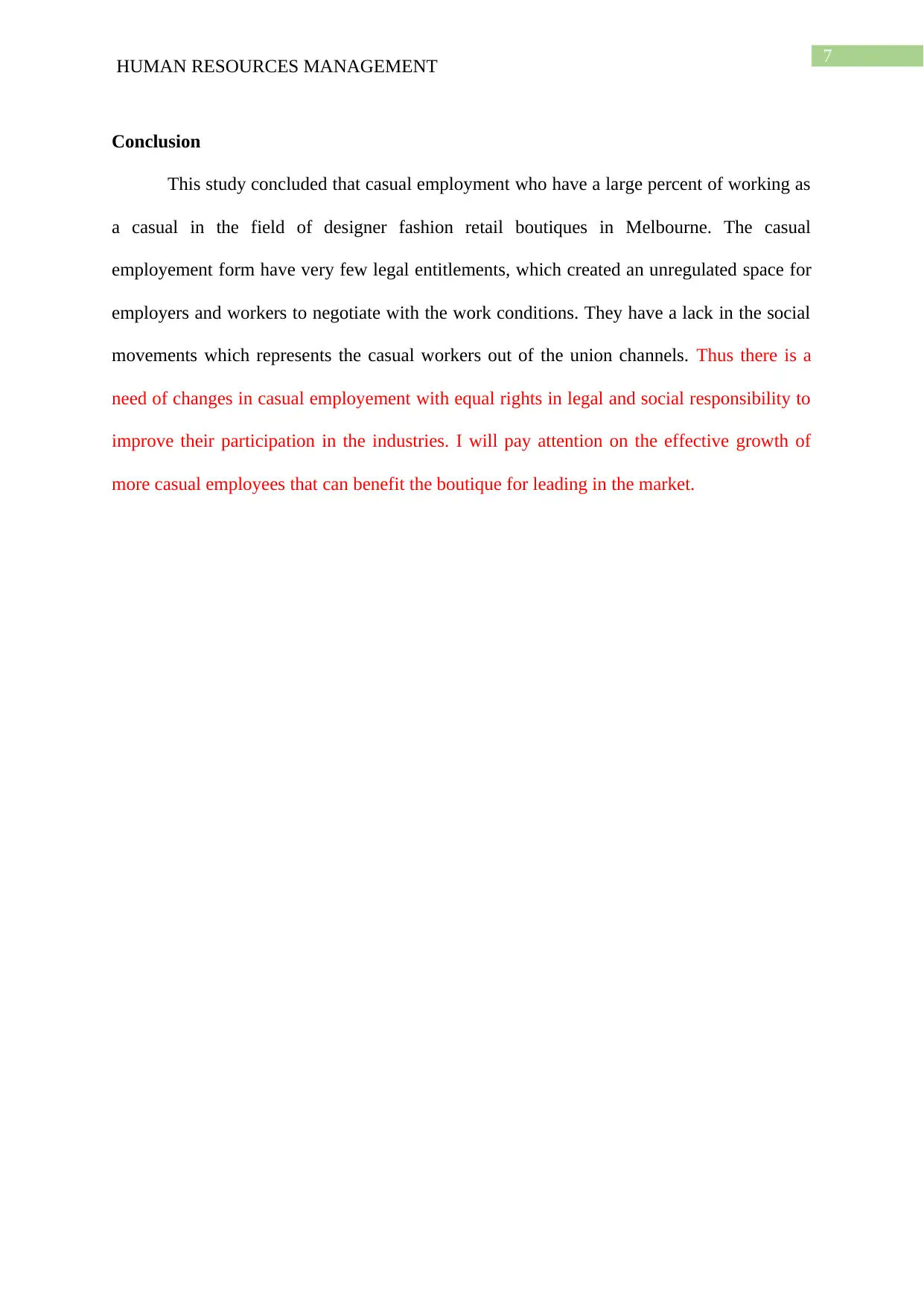
7
HUMAN RESOURCES MANAGEMENT
Conclusion
This study concluded that casual employment who have a large percent of working as
a casual in the field of designer fashion retail boutiques in Melbourne. The casual
employement form have very few legal entitlements, which created an unregulated space for
employers and workers to negotiate with the work conditions. They have a lack in the social
movements which represents the casual workers out of the union channels. Thus there is a
need of changes in casual employement with equal rights in legal and social responsibility to
improve their participation in the industries. I will pay attention on the effective growth of
more casual employees that can benefit the boutique for leading in the market.
HUMAN RESOURCES MANAGEMENT
Conclusion
This study concluded that casual employment who have a large percent of working as
a casual in the field of designer fashion retail boutiques in Melbourne. The casual
employement form have very few legal entitlements, which created an unregulated space for
employers and workers to negotiate with the work conditions. They have a lack in the social
movements which represents the casual workers out of the union channels. Thus there is a
need of changes in casual employement with equal rights in legal and social responsibility to
improve their participation in the industries. I will pay attention on the effective growth of
more casual employees that can benefit the boutique for leading in the market.
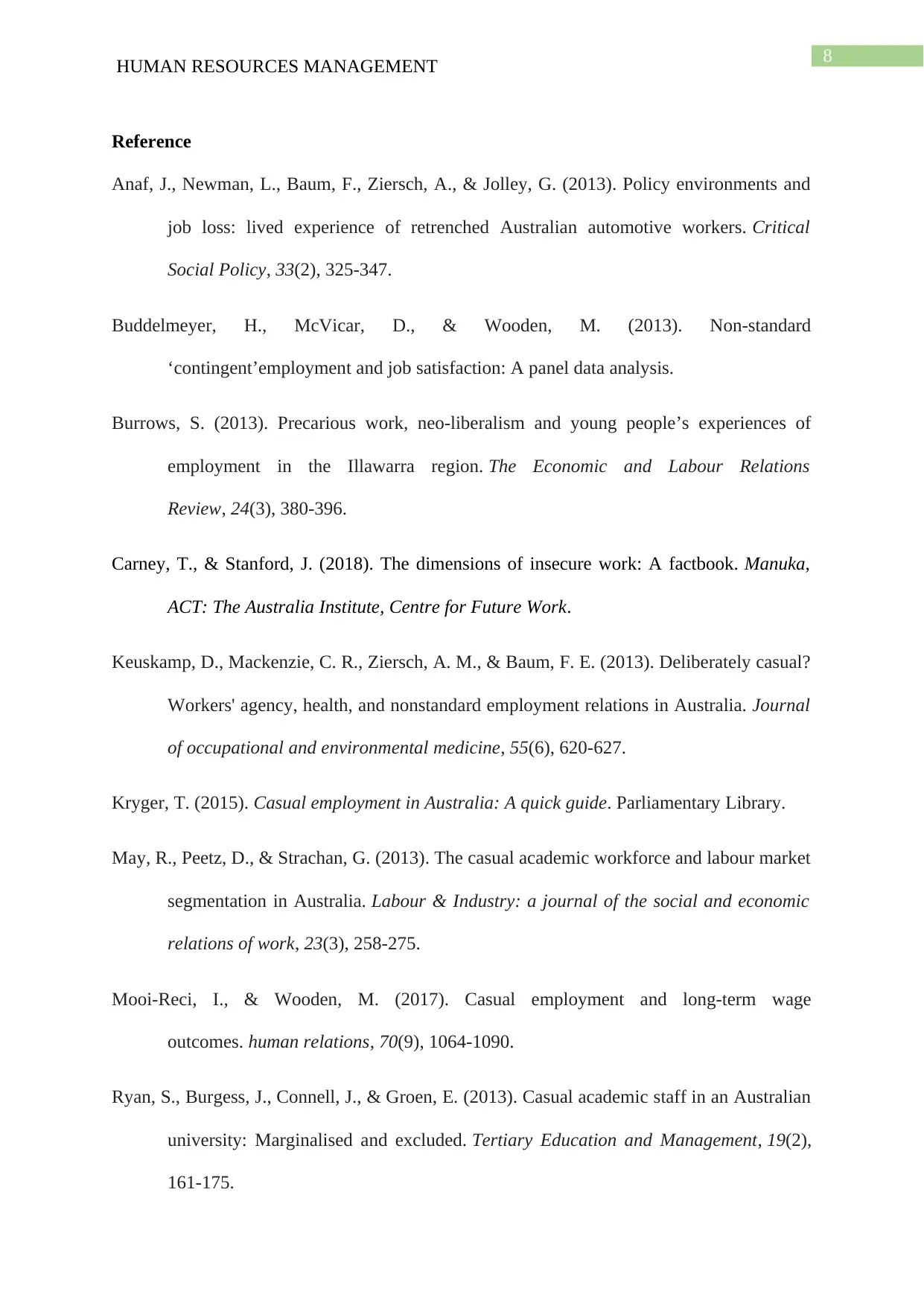
8
HUMAN RESOURCES MANAGEMENT
Reference
Anaf, J., Newman, L., Baum, F., Ziersch, A., & Jolley, G. (2013). Policy environments and
job loss: lived experience of retrenched Australian automotive workers. Critical
Social Policy, 33(2), 325-347.
Buddelmeyer, H., McVicar, D., & Wooden, M. (2013). Non-standard
‘contingent’employment and job satisfaction: A panel data analysis.
Burrows, S. (2013). Precarious work, neo-liberalism and young people’s experiences of
employment in the Illawarra region. The Economic and Labour Relations
Review, 24(3), 380-396.
Carney, T., & Stanford, J. (2018). The dimensions of insecure work: A factbook. Manuka,
ACT: The Australia Institute, Centre for Future Work.
Keuskamp, D., Mackenzie, C. R., Ziersch, A. M., & Baum, F. E. (2013). Deliberately casual?
Workers' agency, health, and nonstandard employment relations in Australia. Journal
of occupational and environmental medicine, 55(6), 620-627.
Kryger, T. (2015). Casual employment in Australia: A quick guide. Parliamentary Library.
May, R., Peetz, D., & Strachan, G. (2013). The casual academic workforce and labour market
segmentation in Australia. Labour & Industry: a journal of the social and economic
relations of work, 23(3), 258-275.
Mooi-Reci, I., & Wooden, M. (2017). Casual employment and long-term wage
outcomes. human relations, 70(9), 1064-1090.
Ryan, S., Burgess, J., Connell, J., & Groen, E. (2013). Casual academic staff in an Australian
university: Marginalised and excluded. Tertiary Education and Management, 19(2),
161-175.
HUMAN RESOURCES MANAGEMENT
Reference
Anaf, J., Newman, L., Baum, F., Ziersch, A., & Jolley, G. (2013). Policy environments and
job loss: lived experience of retrenched Australian automotive workers. Critical
Social Policy, 33(2), 325-347.
Buddelmeyer, H., McVicar, D., & Wooden, M. (2013). Non-standard
‘contingent’employment and job satisfaction: A panel data analysis.
Burrows, S. (2013). Precarious work, neo-liberalism and young people’s experiences of
employment in the Illawarra region. The Economic and Labour Relations
Review, 24(3), 380-396.
Carney, T., & Stanford, J. (2018). The dimensions of insecure work: A factbook. Manuka,
ACT: The Australia Institute, Centre for Future Work.
Keuskamp, D., Mackenzie, C. R., Ziersch, A. M., & Baum, F. E. (2013). Deliberately casual?
Workers' agency, health, and nonstandard employment relations in Australia. Journal
of occupational and environmental medicine, 55(6), 620-627.
Kryger, T. (2015). Casual employment in Australia: A quick guide. Parliamentary Library.
May, R., Peetz, D., & Strachan, G. (2013). The casual academic workforce and labour market
segmentation in Australia. Labour & Industry: a journal of the social and economic
relations of work, 23(3), 258-275.
Mooi-Reci, I., & Wooden, M. (2017). Casual employment and long-term wage
outcomes. human relations, 70(9), 1064-1090.
Ryan, S., Burgess, J., Connell, J., & Groen, E. (2013). Casual academic staff in an Australian
university: Marginalised and excluded. Tertiary Education and Management, 19(2),
161-175.
⊘ This is a preview!⊘
Do you want full access?
Subscribe today to unlock all pages.

Trusted by 1+ million students worldwide
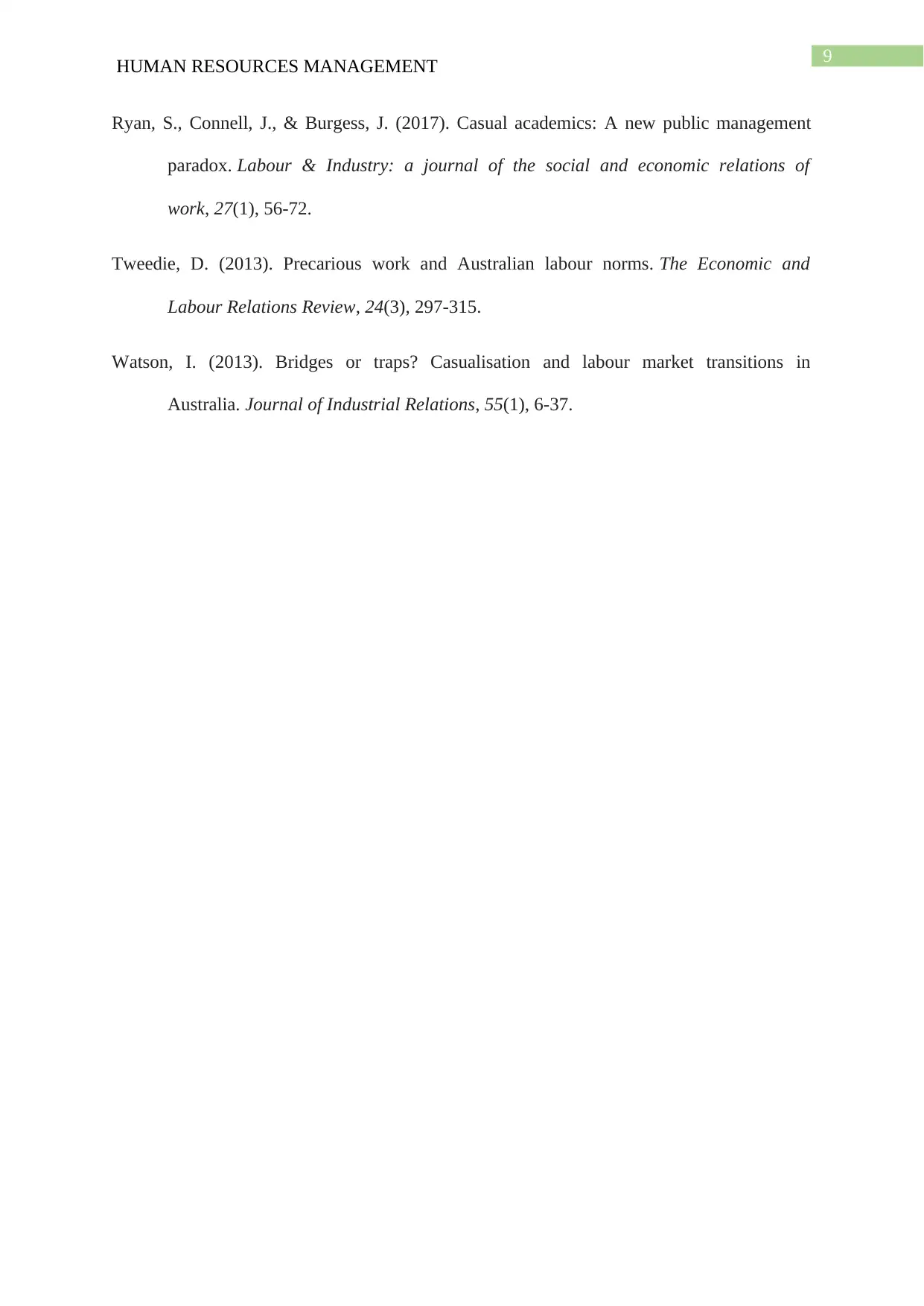
9
HUMAN RESOURCES MANAGEMENT
Ryan, S., Connell, J., & Burgess, J. (2017). Casual academics: A new public management
paradox. Labour & Industry: a journal of the social and economic relations of
work, 27(1), 56-72.
Tweedie, D. (2013). Precarious work and Australian labour norms. The Economic and
Labour Relations Review, 24(3), 297-315.
Watson, I. (2013). Bridges or traps? Casualisation and labour market transitions in
Australia. Journal of Industrial Relations, 55(1), 6-37.
HUMAN RESOURCES MANAGEMENT
Ryan, S., Connell, J., & Burgess, J. (2017). Casual academics: A new public management
paradox. Labour & Industry: a journal of the social and economic relations of
work, 27(1), 56-72.
Tweedie, D. (2013). Precarious work and Australian labour norms. The Economic and
Labour Relations Review, 24(3), 297-315.
Watson, I. (2013). Bridges or traps? Casualisation and labour market transitions in
Australia. Journal of Industrial Relations, 55(1), 6-37.
1 out of 10
Related Documents
Your All-in-One AI-Powered Toolkit for Academic Success.
+13062052269
info@desklib.com
Available 24*7 on WhatsApp / Email
![[object Object]](/_next/static/media/star-bottom.7253800d.svg)
Unlock your academic potential
Copyright © 2020–2025 A2Z Services. All Rights Reserved. Developed and managed by ZUCOL.




